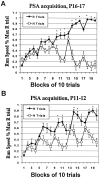Extinction of behavior in infant rats: development of functional coupling between septal, hippocampal, and ventral tegmental regions
- PMID: 10493765
- PMCID: PMC6783035
- DOI: 10.1523/JNEUROSCI.19-19-08646.1999
Extinction of behavior in infant rats: development of functional coupling between septal, hippocampal, and ventral tegmental regions
Abstract
Learning of a behavior at a particular age during the postnatal period presumably occurs when the functional brain circuit mediating the behavior matures. The inability to express a learned behavior, such as inhibition, may be accounted for by the functional dissociation of brain regions comprising the circuit. In this study we tested this hypothesis by measuring brain metabolic activity, as revealed by fluorodeoxyglucose (FDG) autoradiography, during behavioral extinction in 12- and 17-d-old rat pups. Subjects were first trained on a straight alley runway task known as patterned single alternation (PSA), wherein reward and nonreward trials alternate successively. They were then injected with FDG and given 50 trials of continuous nonreward (i.e., extinction). Pups at postnatal day 12 (P12) demonstrated significantly slower extinction rates compared to their P17 counterparts, despite the fact that both reliably demonstrated the PSA effect, i.e., both age groups distinguished between reward and nonreward trials during acquisition. Covariance analysis revealed that the dentate gyrus, hippocampal fields CA1-3, subiculum, and lateral septal area were significantly correlated in P17 but not P12 pups. Significant correlations were also found between the lateral septal area, ventral tegmental area, and the medial septal nucleus in P17 pups. Similar correlative patterns were not found in P12 and P17 handled control animals. Taken together, these results suggest that septal, hippocampal, and mesencephalic regions may be functionally dissociated at P12, and the subsequent maturation of functional connectivity between these regions allows for the more rapid expression of behavioral inhibition during extinction at P17.
Figures








References
-
- Amaral DG, Dent JA. Development of the mossy fibers of the dentate gyrus: a light and electron microscopic study of the mossy fibers and their expansions. J Comp Neurol. 1981;195:51–86. - PubMed
-
- Amsel A. Frustration theory. Cambridge UP; New York: 1992.
-
- Bowe MA, Nadler JV. Developmental increase in the sensitivity to magnesium of NMDA receptors on CA1 hippocampal pyramidal cells. Dev Brain Res. 1990;56:55–61. - PubMed
-
- Bronstein PM, Neiman H, Wolkoff FD, Levine MJ. The development of habituation in the rat. Anim Learn Behav. 1971;2:92–96.
-
- Chugani HT, Phelps ME. Maturational changes in cerebral function in infants determined by [18]FDG positron emission tomography. Science. 1986;231:840–843. - PubMed
Publication types
MeSH terms
Substances
Grants and funding
LinkOut - more resources
Full Text Sources
Medical
Research Materials
Miscellaneous
